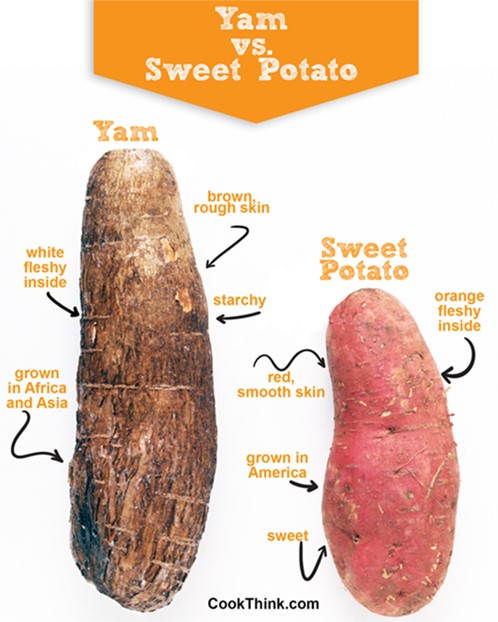
Credit: CookThink.com
When is a potato not a potato? When it’s a sweet potato!
And when is a sweet potato not a sweet potato? When it’s a yam!
What I mean is, these three food staples may look similar, but they’re not related at all.
The potato is part of the nightshade family; it’s actually kin to tomatoes, eggplant and tobacco.
It comes originally from the Andes, where the Incas domesticated potatoes many centuries ago. In Peru, there are still more than 4,000 varieties!
Potatoes went to Europe with Spanish sailors in the 16th century, who realized their vitamin C prevented scurvy. Then they made their way to North America and around the world.
Today the potato is the fourth-largest food crop, behind maize, rice and wheat, with China and India the biggest producers.
The sweet potato, meanwhile, came from the tropics in Central America and the Caribbean, from a vine related to the morning glory flower …
While the yam comes from the lily family. Different species were domesticated in different places, perhaps as early as 10,000 years ago in Africa.
West African slaves brought the culture of cooking yams to the Americas, but unable to find the real deal, they substituted sweet potatoes and called them yams, and the naming mash-up began.
No matter. All three of these tubers are good sources of complex carbohydrates, dietary fiber, vitamins and minerals, so you might as well eat them all!
Background
Synopsis: Those candied yams on your Thanksgiving menu are made of sweet potatoes, not yams—the transatlantic slave trade’s role in American history created the confusion. And neither yams nor sweet potatoes are related to your mashed potatoes. All three are tubers that grow underground and are staple foods around the globe, but that is where the similarity ends. Yams, sweet potatoes, and potatoes all come from completely different plant families with their own unique histories.
- Potatoes, sweet potatoes, and yams are underground tubers, or root vegetables.
- Tubers are fleshy, enlarged stems or roots that evolved as a mechanism for underground nutrient storage, enabling plants to stockpile resources for plant regrowth and asexual propagation during the next growing season. Plants with tubers also flower and produce seeds, so they have two means of regrowth.
- Stem tubers form along thickened stems that run underground, while root tubers form along the root system of the plant.
- These three starchy staple crops come from three distinct plant families that were domesticated multiple times on different continents.
- Potatoes originated in South America and are stem tubers from flowering bushes (Solanum tuberosum) of the nightshade family (Solanaceae) that includes tomatoes, peppers, eggplants, and tobacco.

Potatoes (S. tuberosum) grow on the buried modified stems of a flowering bush.
Credit: Danny S., CC BY-SA 4.0, via Wikimedia Commons - Sweet potatoes come from the tropics of Central America and are the root tubers of vines (Ipomoea batatas) within the morning glory family (Convolvulaceae).
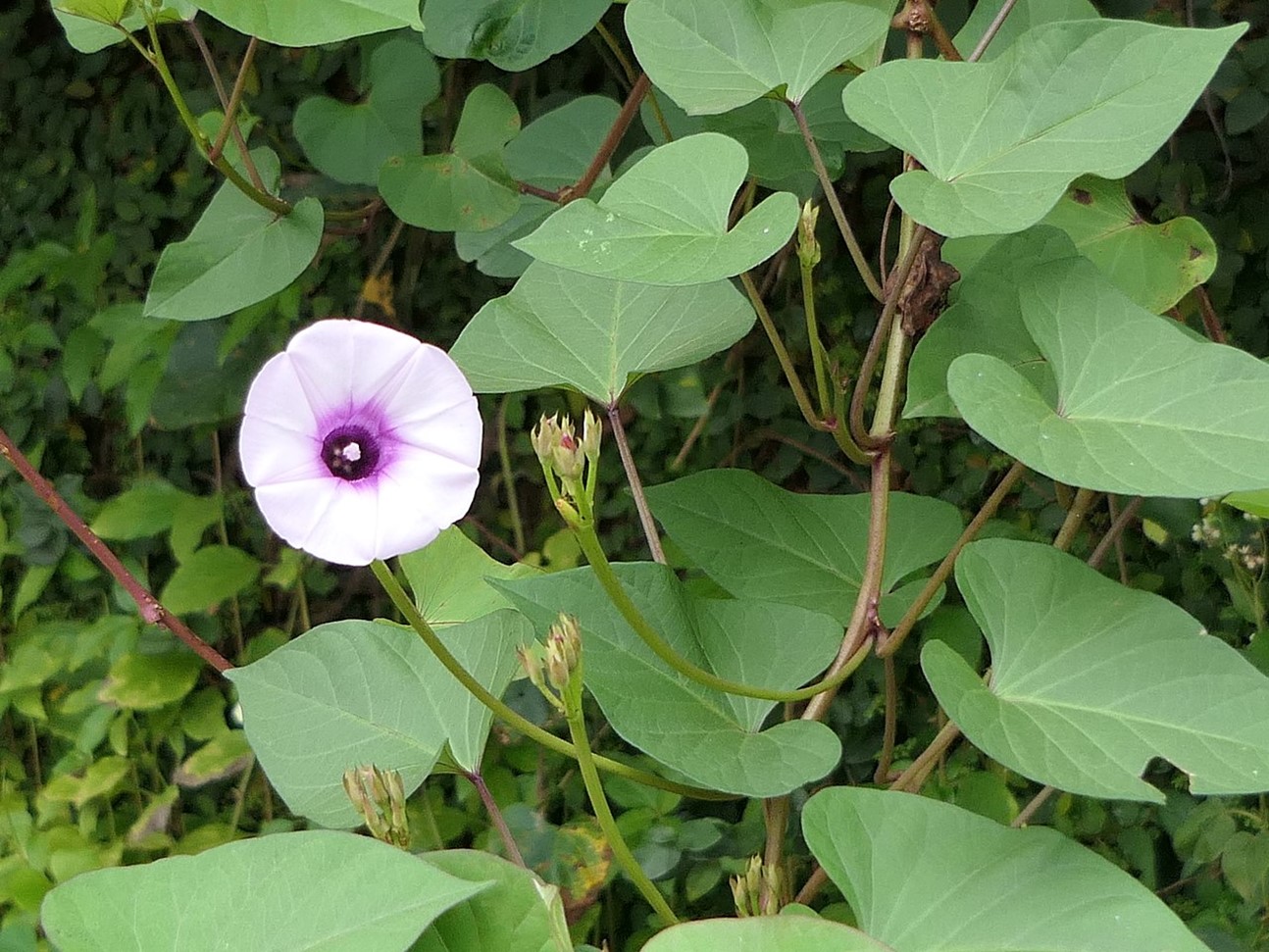
Sweet potato (I. batatas) vines, leaves and flowers resemble their cousin, the morning glory.
Credit: Dinesh Valke from Thane, India, via Wikimedia Commons - Yams are stem tubers (genus Dioscorea) from the Dioscoreaceae family, related to lilies and grasses. Different species of yams were independently domesticated in Africa, Asia, and the Americas.
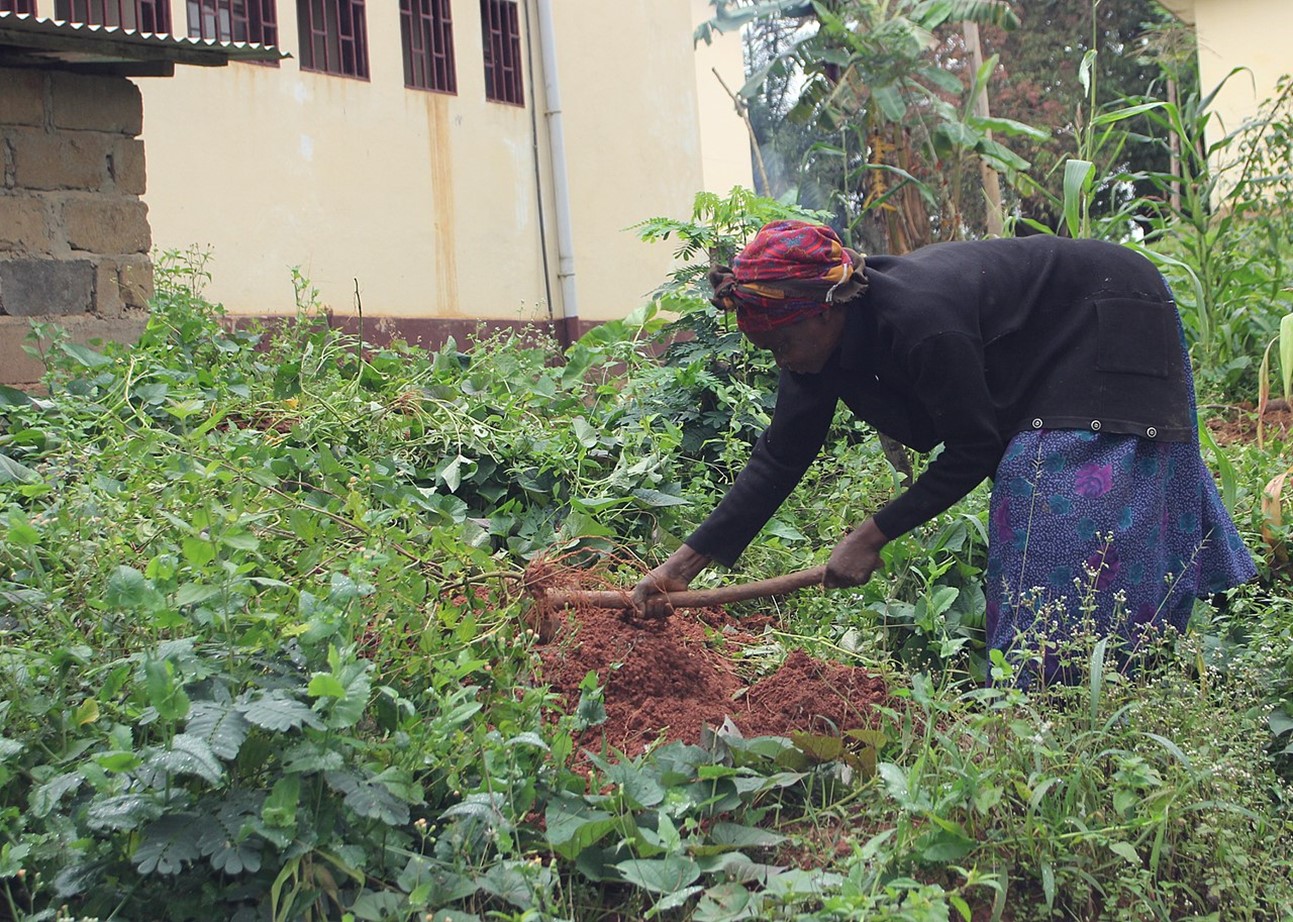
Harvesting yams (Dioscorea sp.) in Cameroon. Yams come from the same family as lilies and grasses, and the tubers grow along modified stems that run underground.
Credit: Bediong, CC BY-SA 4.0, via Wikimedia Commons
- Potatoes originated in South America and are stem tubers from flowering bushes (Solanum tuberosum) of the nightshade family (Solanaceae) that includes tomatoes, peppers, eggplants, and tobacco.
- Potatoes originated in the Andean region of South America, specifically in the region that is now Peru and Bolivia.
- Potatoes diverged from their poisonous nightshade ancestors in the late Paleozoic Carboniferous Period about 350 million years ago.
- Solanum tuberosum was first domesticated by Indigenous peoples in the region about 10,000 years ago and became an important staple crop in their diets.
- Potatoes were first introduced to Europe in the 16th century, after Spanish conquistadors brought them back from South America. Vitamin C in the vegetables prevents scurvy among sailors.
- In a previous EarthDate (ED-233 Yes, We Had No Bananas) we talked about the 1845–1855 Irish potato blight caused by a fungal contagion that wiped out a vital monocultural crop.

Potatoes (S. tuberosum) are stem tubers of a bush with more than 4,000 varieties.
Credit: BASFPlantScience, via Wikimedia Commons - Today, potatoes are the fourth-largest food crop in the world after maize, rice and wheat, with the highest production coming from China, India, Ukraine, the United States and Germany.
- Peru is home to more than 4,000 different potato varieties.
- Potatoes have a smooth, thin skin and a white or yellow flesh with an earthy flavor when cooked.
- Potatoes are a good source of vitamin C, potassium, and dietary fiber, but they are higher in carbohydrates and lower in other nutrients than sweet potatoes and yams.
- Sweet potatoes are vines native to the tropical regions of the Americas, including Central and South America, as well as the Caribbean.
- Scientists have shown that sweet potato vines and their tubers originated at least 800,000 years ago (during the Pleistocene Epoch), and possibly as early as 2 million years ago (during the late Pliocene Epoch).
- They were first cultivated by Indigenous peoples of America’s tropics around 2500–1850 BC and have been an important crop in their diets ever since.
- Sweet potatoes were introduced to other parts of the world, including Asia, Africa, and Europe, by both natural dispersion and by seafaring explorers.
- There are thousands of varieties of I. batatas that vary in skin color, flesh color, and sugar content.

The root tuber of a sweet potato (I. batatas) plant, sometimes found in a purple Asian ice cream.
Credit: miya, via Wikimedia Commons - Sweet potatoes have smooth skin with colors varying from beige to yellow, orange, red, purple, or brown. They are tapered at both ends, with their sweet moist flesh ranging from purple to orange to white.
- Sweet potatoes are particularly rich in beta-carotene, a type of vitamin A, which gives them their distinctive orange color. They are also a good source of vitamin C, potassium, and dietary fiber.
- Yams are vines that have been cultivated by Indigenous peoples for thousands of years.
- Early in the Jurassic period, around 200 million years ago, monocots like grass, palm trees, and yams diverged from other angiosperms called dicots. Monocots have only one embryonic leaf, called a cotyledon, while dicots have two. Yams probably evolved sometime between 45 million years ago (during the early Tertiary Period) and 70 million years ago (during the Late Cretaceous Period).
- Archaeological evidence suggests yams (Dioscorea rotundata) have been cultivated in West Africa since 8000 BC, while other species of yams were cultivated in the Americas (Dioscorea trifida) and Asia (Dioscorea alata).
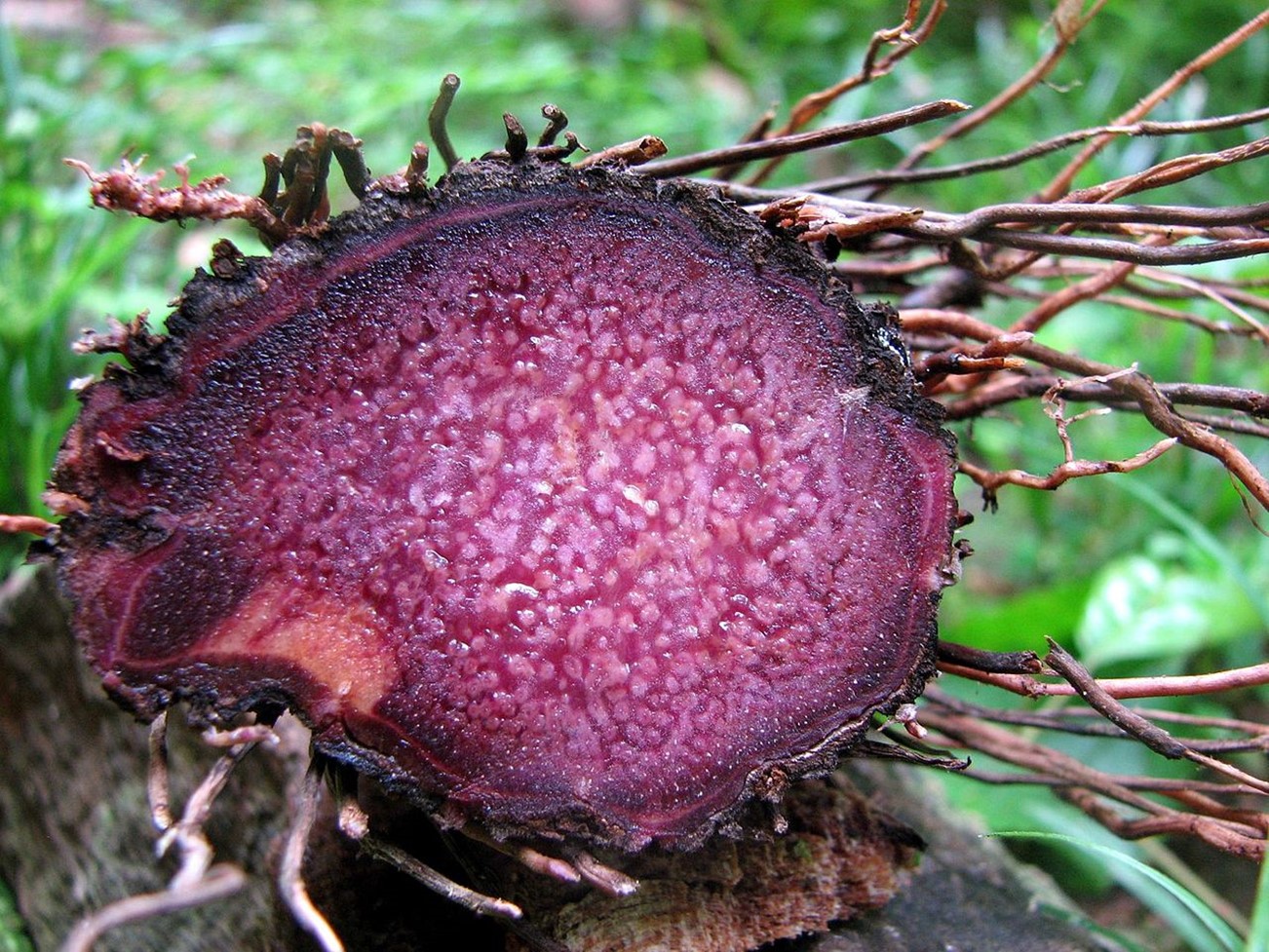
A recently harvested and sliced ube, a purple yam (D. alata), is native to Southeast Asia and used as an ingredient in desserts and ice creams.
Credit: Deepugn at Malayalam Wikipedia, public domain, via Wikimedia Commons - Today, 95% of yam crops are grown in Africa, but yams are also grown in many tropical regions around the world, including the Caribbean, South America, Asia and the Pacific Islands. More than 870 species of yams exist.
- Yam vines can grow to nearly 50 ft (15 m) in length, and the edible tubers may grow as long as 5 ft (1.5 m) into the soil. These tubers can be stored for four to six months without refrigeration and are staple crops.
- The tubers usually have scaly, rough, bark-like black to brown skins with white to yellow, starchy flesh inside with a drier potato-like starchiness.
- Yams are consumed as cooked pieces of flesh or made into flour. Some species must be cooked, because they contain substances that can be toxic if consumed raw. In the United States, Dioscorea are typically only found in specialty markets, such as those that serve Asian or Caribbean communities.
- Yams are also a good source of dietary fiber and potassium as well as vitamin C and vitamin B6, which support perceived energy levels and brain function.
- So, why do Americans call some sweet potatoes yams? Because enslaved Africans were transported to the Americas, and their main staple crop in Africa was yam.
- Yams were so important in West Africa that the word “yam” is derived from “nyami,” which mean “to eat” in some West African dialects.
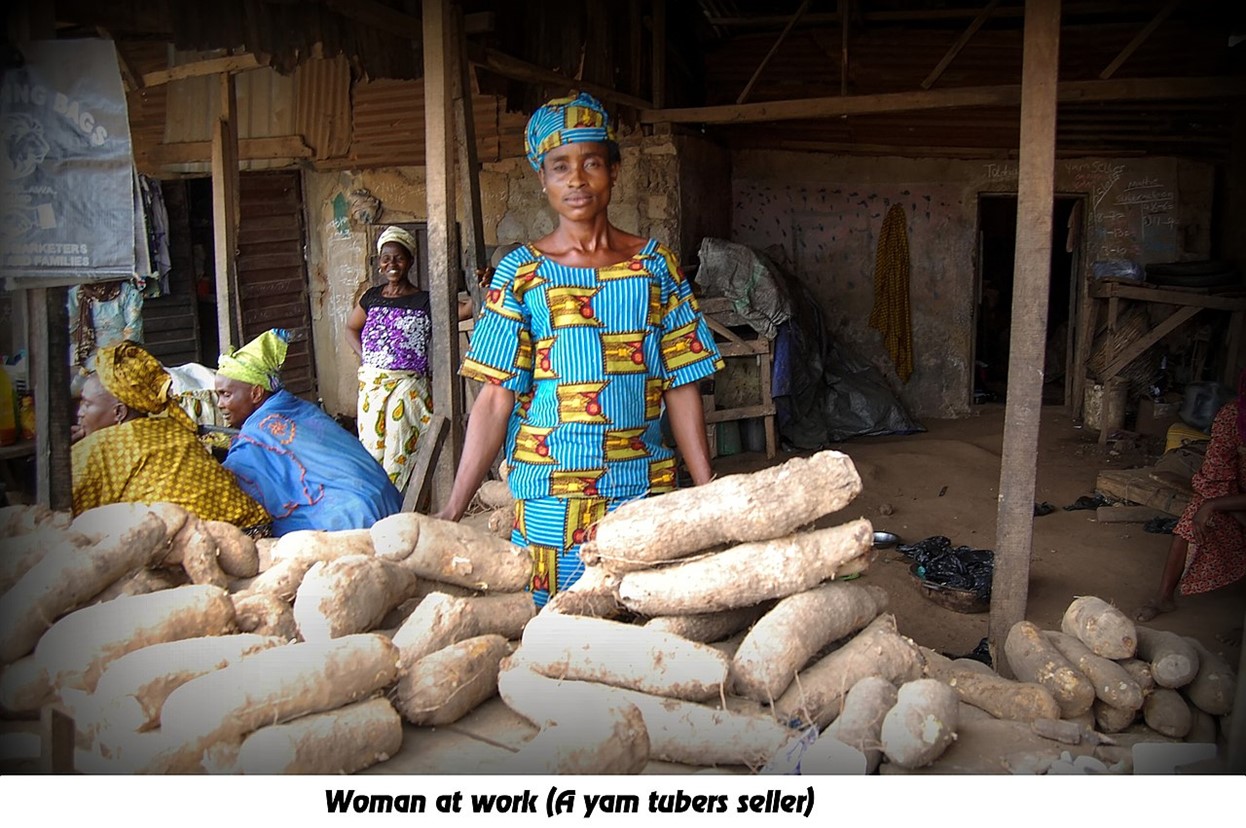
A woman selling yam tubers (Dioscorea sp.) in Nigeria.
Credit: Salam Abiodun, CC BY-SA 4.0, via Wikimedia Commons - The transatlantic slave trade depended on yams to feed enslaved Africans as they crossed the Atlantic. Slaves brought knowledge of cultivation and preparation of yams to America, but they did not find native yams in America.
- Lacking African yams (D. rotundata) to eat, slaves substituted the sweet potato in their diets and began referring to I. batatas as “nyami,” or yam.
- Early sweet potatoes in the United States were the firmer varieties, but eventually, soft varieties with moist, deep-orange flesh were cultivated. In 1937, farmers in Louisiana began marketing these softer sweet potatoes as “yams” to distinguish them from the firm varieties, and the name stuck.
- Today, the U.S. Department of Agriculture (USDA) requires any I. batatas labeled as a yam to also be labeled as a sweet potato. But distributors figured out that Americans are willing to pay more for a vegetable labeled “yam” than for the same one labeled “sweet potato,” so they include the words in tiny letters: “SWEET POTATO” Buyer beware!
- Yams were so important in West Africa that the word “yam” is derived from “nyami,” which mean “to eat” in some West African dialects.

